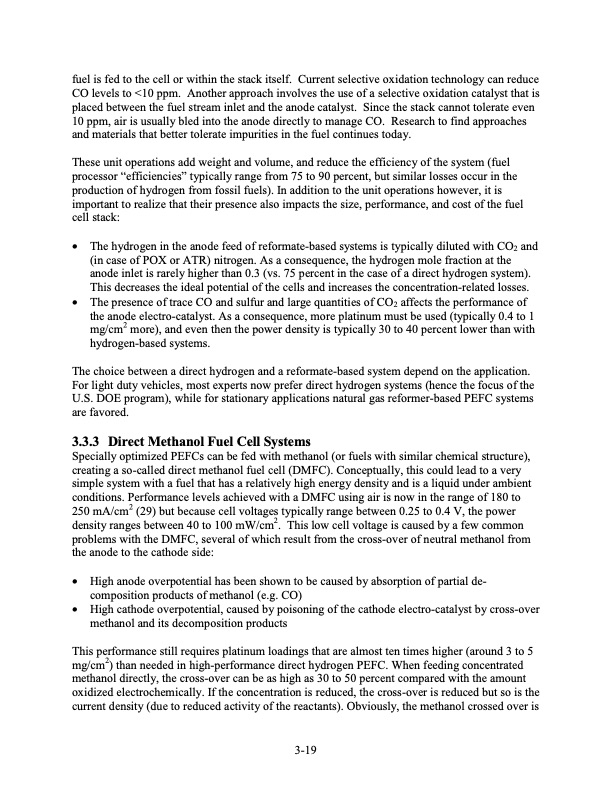
PDF Publication Title:
Text from PDF Page: 106
fuel is fed to the cell or within the stack itself. Current selective oxidation technology can reduce CO levels to <10 ppm. Another approach involves the use of a selective oxidation catalyst that is placed between the fuel stream inlet and the anode catalyst. Since the stack cannot tolerate even 10 ppm, air is usually bled into the anode directly to manage CO. Research to find approaches and materials that better tolerate impurities in the fuel continues today. These unit operations add weight and volume, and reduce the efficiency of the system (fuel processor “efficiencies” typically range from 75 to 90 percent, but similar losses occur in the production of hydrogen from fossil fuels). In addition to the unit operations however, it is important to realize that their presence also impacts the size, performance, and cost of the fuel cell stack: • The hydrogen in the anode feed of reformate-based systems is typically diluted with CO2 and (in case of POX or ATR) nitrogen. As a consequence, the hydrogen mole fraction at the anode inlet is rarely higher than 0.3 (vs. 75 percent in the case of a direct hydrogen system). This decreases the ideal potential of the cells and increases the concentration-related losses. • The presence of trace CO and sulfur and large quantities of CO2 affects the performance of the anode electro-catalyst. As a consequence, more platinum must be used (typically 0.4 to 1 mg/cm2 more), and even then the power density is typically 30 to 40 percent lower than with hydrogen-based systems. The choice between a direct hydrogen and a reformate-based system depend on the application. For light duty vehicles, most experts now prefer direct hydrogen systems (hence the focus of the U.S. DOE program), while for stationary applications natural gas reformer-based PEFC systems are favored. 3.3.3 DirectMethanolFuelCellSystems Specially optimized PEFCs can be fed with methanol (or fuels with similar chemical structure), creating a so-called direct methanol fuel cell (DMFC). Conceptually, this could lead to a very simple system with a fuel that has a relatively high energy density and is a liquid under ambient conditions. Performance levels achieved with a DMFC using air is now in the range of 180 to 250 mA/cm2 (29) but because cell voltages typically range between 0.25 to 0.4 V, the power density ranges between 40 to 100 mW/cm2. This low cell voltage is caused by a few common problems with the DMFC, several of which result from the cross-over of neutral methanol from the anode to the cathode side: • High anode overpotential has been shown to be caused by absorption of partial de- composition products of methanol (e.g. CO) • High cathode overpotential, caused by poisoning of the cathode electro-catalyst by cross-over methanol and its decomposition products This performance still requires platinum loadings that are almost ten times higher (around 3 to 5 mg/cm2) than needed in high-performance direct hydrogen PEFC. When feeding concentrated methanol directly, the cross-over can be as high as 30 to 50 percent compared with the amount oxidized electrochemically. If the concentration is reduced, the cross-over is reduced but so is the current density (due to reduced activity of the reactants). Obviously, the methanol crossed over is 3-19PDF Image | Fuel Cell Handbook (Seventh Edition)

PDF Search Title:
Fuel Cell Handbook (Seventh Edition)Original File Name Searched:
fuel-cell-handbook.pdfDIY PDF Search: Google It | Yahoo | Bing
NFT (Non Fungible Token): Buy our tech, design, development or system NFT and become part of our tech NFT network... More Info
IT XR Project Redstone NFT Available for Sale: NFT for high tech turbine design with one part 3D printed counter-rotating energy turbine. Be part of the future with this NFT. Can be bought and sold but only one design NFT exists. Royalties go to the developer (Infinity) to keep enhancing design and applications... More Info
Infinity Turbine IT XR Project Redstone Design: NFT for sale... NFT for high tech turbine design with one part 3D printed counter-rotating energy turbine. Includes all rights to this turbine design, including license for Fluid Handling Block I and II for the turbine assembly and housing. The NFT includes the blueprints (cad/cam), revenue streams, and all future development of the IT XR Project Redstone... More Info
Infinity Turbine ROT Radial Outflow Turbine 24 Design and Worldwide Rights: NFT for sale... NFT for the ROT 24 energy turbine. Be part of the future with this NFT. This design can be bought and sold but only one design NFT exists. You may manufacture the unit, or get the revenues from its sale from Infinity Turbine. Royalties go to the developer (Infinity) to keep enhancing design and applications... More Info
Infinity Supercritical CO2 10 Liter Extractor Design and Worldwide Rights: The Infinity Supercritical 10L CO2 extractor is for botanical oil extraction, which is rich in terpenes and can produce shelf ready full spectrum oil. With over 5 years of development, this industry leader mature extractor machine has been sold since 2015 and is part of many profitable businesses. The process can also be used for electrowinning, e-waste recycling, and lithium battery recycling, gold mining electronic wastes, precious metals. CO2 can also be used in a reverse fuel cell with nafion to make a gas-to-liquids fuel, such as methanol, ethanol and butanol or ethylene. Supercritical CO2 has also been used for treating nafion to make it more effective catalyst. This NFT is for the purchase of worldwide rights which includes the design. More Info
NFT (Non Fungible Token): Buy our tech, design, development or system NFT and become part of our tech NFT network... More Info
Infinity Turbine Products: Special for this month, any plans are $10,000 for complete Cad/Cam blueprints. License is for one build. Try before you buy a production license. May pay by Bitcoin or other Crypto. Products Page... More Info
| CONTACT TEL: 608-238-6001 Email: greg@infinityturbine.com | RSS | AMP |